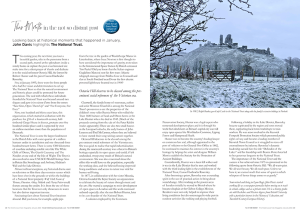
This coming year, the next time you tour a beautiful garden, take in the panorama from a coastal path, marvel at the splendours inside a stately home or explore the past at an historical site make time for a silent prayer of thanks and dedicate it to the social reformer Octavia Hill, the lawyer Sir Robert Hunter and the priest Canon Hardwicke Rawnsley.
For, in January 1895, these were the three people who had the vision and determination to set up The National Trust so that the natural environment and historic places could be protected for future generations. The zeal with which these individuals founded the National Trust was focused around two slogans and gave it its raison-d’etre from the outset: “Save Sites, Open Them Up” and “For Everyone, For Ever.”
Now, one hundred and thirty years later, this organisation, which started its collection with the purchase for £10 of a fourteenth century, half-timbered Clergy House in Sussex, protects over five hundred similar places and is supported by over six million members-more than the population of Denmark.
The National Trust is now the largest landowner in the British Isles with some quarter of a million hectares under its jurisdiction and one thousand three hundred tenant farms. There is some 1300 kilometres of coastline including notable sites like The White Cliffs of Dover, The Giant’s Causeway and The Needles at one end of the Isle of Wight. The Trust is also involved in nine UNESCO World Heritage Sites in Britain like Stonehenge and Avebury, Hadrian’s Wall and the Lake District.
Almost without exception, any historical drama seen on television or film these days contains scenes which have been shot in the grounds or within the buildings of a National Trust property. Wolf Hall, Game of Thrones, Downton Abbey, Poldark and Harry Potter would feature among the credits. It is from the use of these locations that the Trust not only showcases its wares but also derives important income.
Fascinating facts about National Trust locations abound. Did you know, for example, apple pips from the tree in the garden at Woolsthorpe Manor in Lincolnshire, where Isaac Newton is first thought to have considered the importance of gravity, were taken to the International Space Station by British astronaut Tim Peake? Did you know that the Italian engineer Guglielmo Marconi sent his first trans-Atlantic telegraph message from Poldhu Cove in Cornwall and that at South Foreland near Dover the first electric powered lighthouse beamed out in 1904?
Chartwell, the family home of statesman, author and artist Winston Churchill is among the National Trust’s possession as are the properties of the children’s story-teller Beatrix Potter who willed the Trust 1600 hectares of land and fifteen farms in the Lake District when she died in 1943. (Much of the proceeds coming from the sale of the Peter Rabbit stories apparently.) There are also two small houses in the Liverpool suburbs, the early homes of John Lennon and Paul McCartney, where they are believed to have started their song-writing careers together.
Octavia Hill deserves to be classed among the pre-eminent social reformers of the Victorian era. She was quick to realise that rapid industrialisation during the nineteenth century was a threat to Britain’s heritage especially its open spaces and could, if left unchecked, sweep away much of Britain’s natural environment. She was also concerned about the effect this would have on the population, especially the working class, and she believed having improved living conditions and access to nature was vital for human well-being.
In 1877, in collaboration with her sister Miranda, Octavia founded the Kyrie Society-an organisation to celebrate the beauty of nature through music and the arts. She started a campaign to resist development of open spaces in London and this work continued unbated especially after she met Robert Hunter, later to be a co-founder of the National Trust.
A solicitor employed by the Commons Preservation Society, Hunter was a legal expert who contested development plans and it is through his work that inhabitants in Britain’s capital city can still enjoy open spaces like Wimbledon Common, Epping Forest and Hampstead Heath.
Hunter was to become the country’s leading lawyer on commons law and, although appointed to the post of solicitor to the General Post Office in 1882, he continued to maintain his interest in the country’s heritage by helping the artist and designer William Morris establish the Society for the Protection of Ancient Buildings.
Coincidentally, Hunter was a keen fell walker and it was in the Lake District that he met and worked with the third leading light in the establishment of the National Trust, Canon Hardwicke Rawnsley.
After becoming a priest, Rawnsley was a crusading spirit in the use of practical action to bring about social change. After working in the poorer areas of London initially he moved to Bristol where he became chaplain at the Clifton College Mission. Residents were not only helped to improve their living conditions but also encouraged to take part in outdoor activities like walking and playing football.
Following a holiday in the Lake District, Rawnsley became captivated by the region and soon moved there, supporting local town workshops to train workers. He was soon involved in the Keswick Footpath Protection Society which preserved public rights-of-way and became a leading member of Keswick Town Council as it struggled to stave off encroachment by industry. Rawnsley’s dynamic leadership earned him the title “Defender of the Lakes” and his friendship with Beatrix Potter later led to her generous bequests to the National Trust.
The importance of the National Trust and the success it has achieved since 1875 is epitomised in the following quote from Octavia Hill: “We all want quiet. We all want beauty. We all need space. Unless we have it, we cannot reach that sense of quiet in which whispers of better things come to us gently.”




